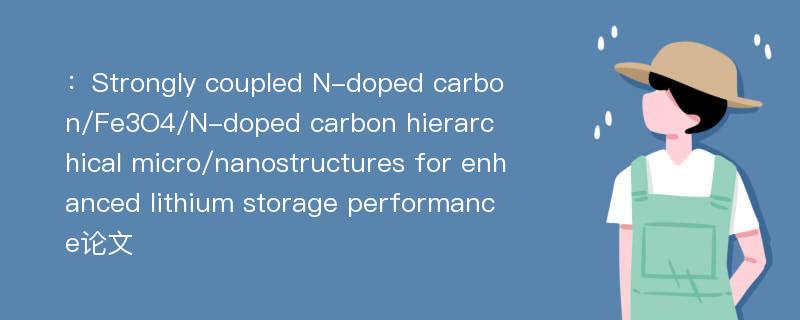
本文主要研究内容
作者(2019)在《Strongly coupled N-doped carbon/Fe3O4/N-doped carbon hierarchical micro/nanostructures for enhanced lithium storage performance》一文中研究指出:A strong interface coupling is of vital importance to develop metal oxide/carbon nanocomposite anodes for next-generation lithium ion batteries.Herein,a rational N-doped carbon riveting strategy is designed to boost the lithium storage performance of Fe3O4/N-doped carbon tubular structures.Polypyrrole(PPy)has been used as the precursor for N-doped carbon.N-doped carbon-riveted Fe3O4/N-doped carbon(N–C@Fe3O4@N–C)nanocomposites were obtained by pyrolysis of PPy-coated FeOOH@PPy nanotubes in Ar atmosphere.When tested as an anode for LIBs,the N–C@Fe3O4@N–C displays a high reversible discharge capacity of 675.8 m A h g-1after 100 cycles at a current density of 100 m A g-1and very good rate capability(470 mA h g-1at 2 A g-1),which significantly surpasses the performance of Fe3O4@N–C.TEM analysis reveals that after battery cycling the FeOxparticles detached from the carbon fibers for Fe3O4@N–C,while for N–C@Fe3O4@N–C the FeOxparticles were still trapped in the carbon matrix,thus preserving good electrical contact.Consequently,the superior performance of N–C@Fe3O4@N–C is attributed to the synergistic effect between Fe3O4and N-doped carbon combined with the unique structure properties of the nanocomposites.The strategy reported in this work is expected to be applicable for designing other electrode materials for LIBs.
Abstract
A strong interface coupling is of vital importance to develop metal oxide/carbon nanocomposite anodes for next-generation lithium ion batteries.Herein,a rational N-doped carbon riveting strategy is designed to boost the lithium storage performance of Fe3O4/N-doped carbon tubular structures.Polypyrrole(PPy)has been used as the precursor for N-doped carbon.N-doped carbon-riveted Fe3O4/N-doped carbon(N–C@Fe3O4@N–C)nanocomposites were obtained by pyrolysis of PPy-coated FeOOH@PPy nanotubes in Ar atmosphere.When tested as an anode for LIBs,the N–C@Fe3O4@N–C displays a high reversible discharge capacity of 675.8 m A h g-1after 100 cycles at a current density of 100 m A g-1and very good rate capability(470 mA h g-1at 2 A g-1),which significantly surpasses the performance of Fe3O4@N–C.TEM analysis reveals that after battery cycling the FeOxparticles detached from the carbon fibers for Fe3O4@N–C,while for N–C@Fe3O4@N–C the FeOxparticles were still trapped in the carbon matrix,thus preserving good electrical contact.Consequently,the superior performance of N–C@Fe3O4@N–C is attributed to the synergistic effect between Fe3O4and N-doped carbon combined with the unique structure properties of the nanocomposites.The strategy reported in this work is expected to be applicable for designing other electrode materials for LIBs.
论文参考文献
论文详细介绍
论文作者分别是来自Journal of Energy Chemistry的,发表于刊物Journal of Energy Chemistry2019年07期论文,是一篇关于,Journal of Energy Chemistry2019年07期论文的文章。本文可供学术参考使用,各位学者可以免费参考阅读下载,文章观点不代表本站观点,资料来自Journal of Energy Chemistry2019年07期论文网站,若本站收录的文献无意侵犯了您的著作版权,请联系我们删除。
